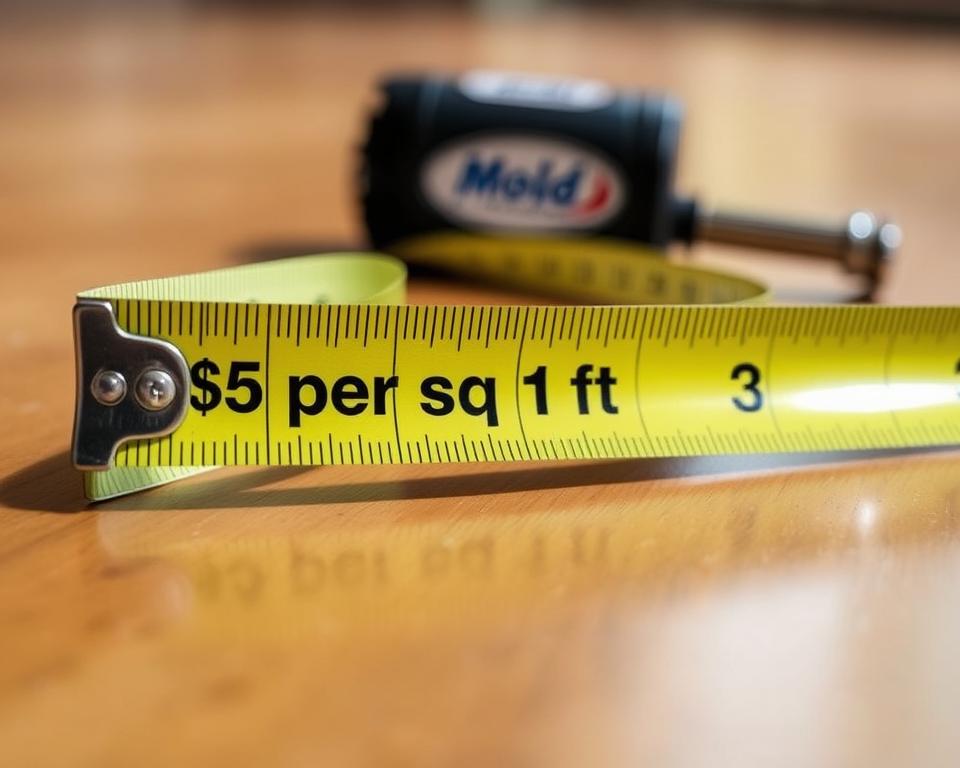Did you know the expenses for addressing fungal growth in your home could vary by thousands of dollars? Many homeowners assume all remediation projects are equally priced, but factors like square footage, contamination severity, and location dramatically influence final bills. This guide clarifies what you’ll likely pay—and why—so you can budget wisely.
Industry data shows most professional services range between $1,500 and $9,000, with an average near $3,500. Smaller areas like bathrooms might only require targeted treatments, while whole-house scenarios demand extensive labor and equipment. We’ll explore how contractors calculate fees and when DIY methods make sense versus hiring experts.
From hidden moisture damage in basements to visible spores on drywall, every situation requires a unique approach. You’ll learn how room size, material porosity, and safety protocols shape pricing structures. Real-world examples illustrate common challenges and solutions, helping you avoid surprises during the process.
Key Takeaways
- Average professional fees fall between $1,500 and $9,000 nationally
- Square footage and contamination level are primary pricing factors
- DIY options exist for minor cases under 10 square feet
- Complex cases involving HVAC systems or structural materials cost more
- Always request itemized quotes to compare service inclusions
Introduction to Mold Removal Cost Considerations
Many residents discover fungal contamination only after health symptoms or property damage arise. These biological growths often appear as discolored patches on walls or ceilings but can hide within walls, under flooring, or in ventilation systems. Left unchecked, they compromise air quality and weaken building materials.
Common Household Challenges
Structural concerns frequently accompany visible growth. Warped drywall, musty odors, and peeling paint often signal deeper moisture issues. While small surface colonies might seem manageable, improper handling can spread spores to new areas.
Financial Planning Essentials
Understanding pricing variables helps homeowners avoid unexpected expenses. Key elements influencing budgets include:
| Factor | Minor Cases | Major Infestations |
|---|---|---|
| Affected Area | Under 10 sq.ft | Entire rooms |
| Treatment Complexity | Surface cleaning | Structural repairs |
| Recommended Approach | DIY solutions | Certified specialists |
| Average Cost Range | $150-$500 | $2,000-$10,000+ |
Professional mold remediation becomes critical when dealing with porous materials like drywall or insulation. Specialized equipment and containment protocols prevent cross-contamination during large-scale projects.
Understanding Mold and Its Associated Risks
Your home’s air quality might deteriorate long before visible signs of biological growth appear. These microorganisms release spores that trigger reactions in sensitive individuals while gradually weakening building materials. Left unaddressed, this dual threat escalates repair bills and health complications.
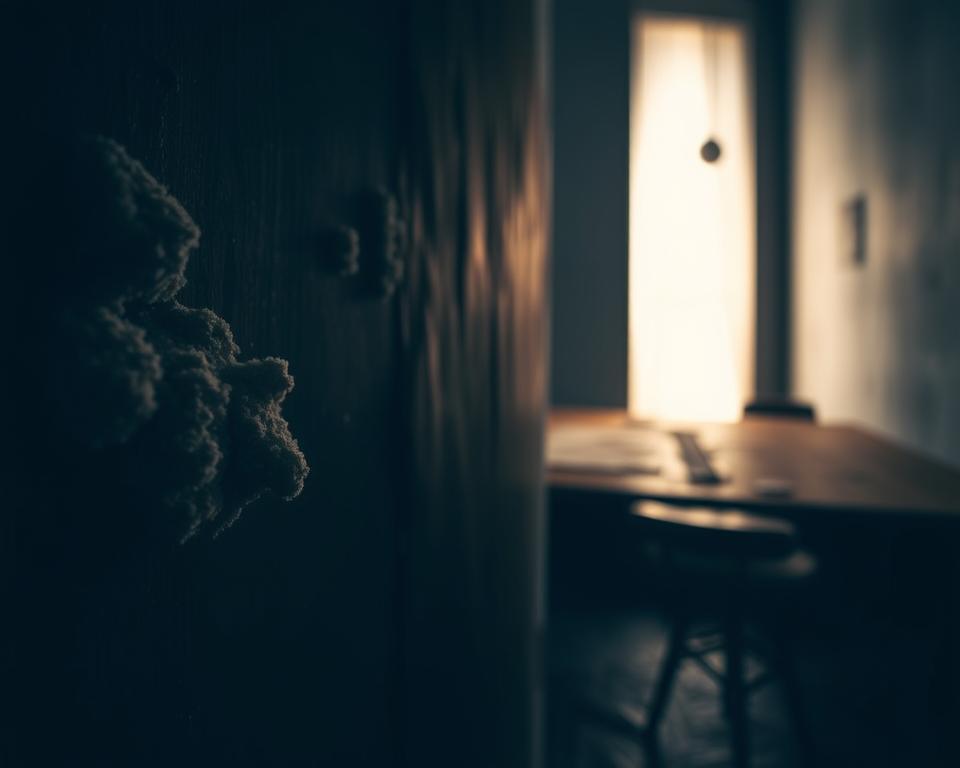
Hidden Dangers to Well-Being
Exposure often begins with subtle symptoms—sneezing fits, itchy eyes, or persistent fatigue. The CDC notes that 20% of asthma cases worsen due to spore inhalation. Vulnerable groups like children and seniors face higher risks of respiratory infections.
Chronic exposure may lead to neurological issues in rare cases. A 2022 indoor air quality study found colonies under 10 square feet can still degrade living conditions significantly. This underscores why early detection matters.
Silent Structural Sabotage
Wooden beams and drywall absorb moisture from active colonies, becoming brittle over time. Flooring adhesives dissolve, while insulation loses thermal efficiency. Many homeowners discover compromised load-bearing walls during renovations—a costly surprise.
Proactive inspections identify hidden growth behind appliances or under carpets before major damage occurs. Addressing small affected areas promptly prevents exponential cost mold increases later. Certified specialists use infrared cameras and moisture meters to locate invisible trouble spots.
Factors Influencing Mold Removal Costs
Where fungi take root in your home plays a pivotal role in determining cleanup expenses. Problematic colonies in tight spaces often demand creative solutions compared to open-surface growths. Service teams assess both physical placement and contamination intensity before providing estimates.
Location and Accessibility
Basement growth typically requires extensive moisture control measures. Attic colonies often involve insulation replacement and air sealing. HVAC system contamination spreads spores rapidly, requiring duct cleaning and filter upgrades.
Contractors charge 30-50% more for cramped crawl spaces versus open rooms. Scaffolding setups or protective containment barriers add labor hours. One industry report shows attic projects average $4,200 compared to $2,800 for accessible main-floor areas.
Affected Area Size and Severity
Surface-level growth under 10 square feet might only need targeted treatment. Widespread infiltration into drywall or subflooring necessitates material replacement. Professional mold remediation becomes essential when colonies penetrate structural components.
Multi-room infestations often double project timelines. Hidden growth behind walls requires exploratory demolition. Service providers use this severity scale:
- Level 1: Isolated, non-porous surfaces ($500-$2,000)
- Level 2: Moderate porous material involvement ($2,000-$6,000)
- Level 3: Extensive structural compromise ($6,000-$15,000)
Final pricing reflects both visible damage and preventative measures against recurrence. Always verify if quotes include post-cleanup air quality testing – a critical step many overlook.
Breakdown of Costs by Affected Areas
Where biological growth appears in your home directly impacts service expenses. Attics, basements, and bathrooms each present unique challenges that shape pricing structures. Let’s examine how location and accessibility drive financial commitments.
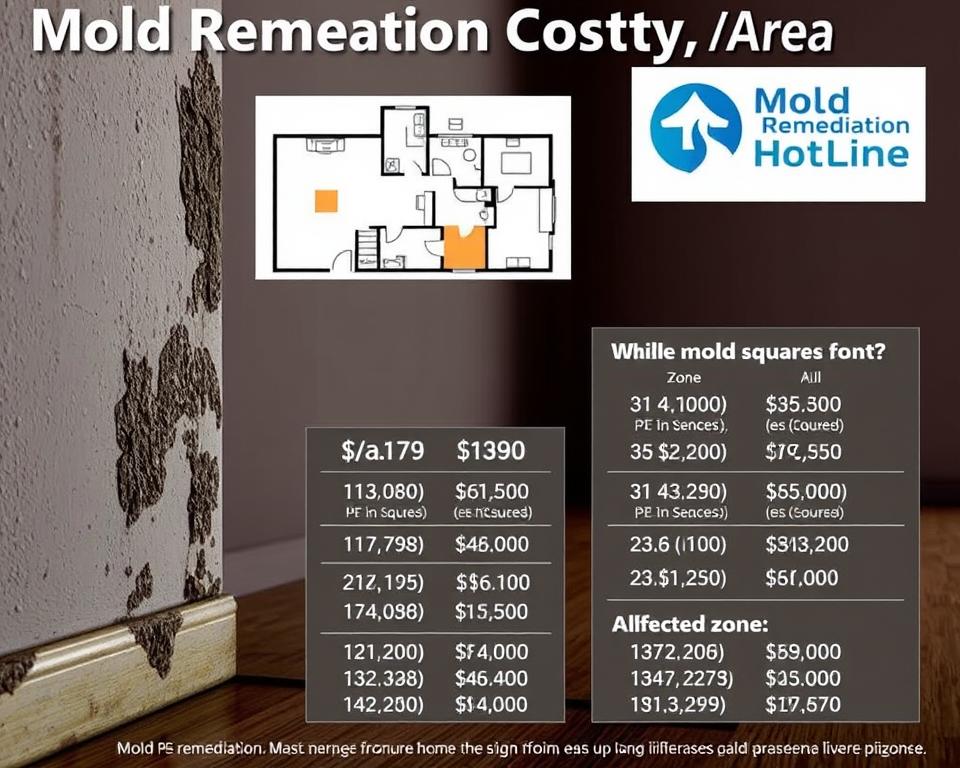
Attics, Basements, and Bathrooms
Attic projects often range from $1,000 to $9,000 due to insulation replacement and air sealing needs. Basements average $500-$4,000 since moisture control measures dominate these spaces. Bathrooms typically cost $300-$2,000 depending on ventilation upgrades.
For instance, a bathroom with surface-level growth might require simple cleaning and grout resealing. However, black mold behind shower tiles could necessitate drywall replacement, doubling expenses. Basements with widespread spore infiltration often demand sump pump installations alongside standard remediation.
Crawl Spaces and HVAC Systems
Tight crawl spaces average $500-$2,000 due to limited worker mobility and protective containment setups. HVAC system contamination ranges from $2,000-$6,000 for duct cleaning and filter replacements. One case study showed a 1,200 sq.ft home’s air handler remediation costing $4,800.
| Area | Average Cost Range | Key Factors |
|---|---|---|
| Attic | $1,000-$9,000 | Insulation, ventilation |
| Basement | $500-$4,000 | Moisture control |
| Bathroom | $300-$2,000 | Tile/grout condition |
| Crawl Space | $500-$2,000 | Access difficulty |
| HVAC System | $2,000-$6,000 | Duct complexity |
Severity dramatically influences final bills—minor surface growth costs 60% less than structural infiltration. Always request moisture mapping reports to understand true contamination scope before approving work.
Mold Species and Cost Implications
Not all fungal growths demand equal treatment—some require military-grade containment while others need basic cleaning. The EPA notes:
“Toxic varieties like Stachybotrys chartarum (black mold) necessitate full isolation protocols, unlike common Cladosporium colonies.”
This biological diversity directly impacts service strategies and budgets.
Dangerous Varieties Demand Specialized Care
Black mold removal often costs 40-60% more than standard treatments. Professionals must seal affected zones with plastic sheeting and use HEPA-filtered negative air machines. Protective gear and disposal fees add $500-$1,200 to projects. Hire professional teams for these hazardous cases—DIY attempts risk spore dispersion and health issues.
Common Types and Budget-Friendly Solutions
Aspergillus and Penicillium colonies under 10 square feet might only need antimicrobial sprays. However, recurring growth in crawl spaces often signals deeper moisture problems. Consider this cost comparison:
| Species | Treatment | Avg. Price (300 sq.ft) |
|---|---|---|
| Stachybotrys | Full containment, material replacement | $4,500-$7,000 |
| Aspergillus | Surface cleaning, dehumidification | $1,200-$2,800 |
| Cladosporium | HEPA vacuuming, encapsulation | $800-$1,500 |
Persistent mold problems in humid areas like basements or crawl spaces often require structural repairs alongside standard remediation. Always test suspicious growths—misidentification leads to inadequate treatments and repeat expenses.
Labor and Material Considerations in Remediation
Understanding the financial breakdown of fungal growth mitigation helps homeowners make informed decisions. Service expenses split between skilled labor and specialized supplies, each playing distinct roles in effective treatment. Industry reports show labor typically consumes 60% of project budgets due to rigorous safety protocols and technical expertise.
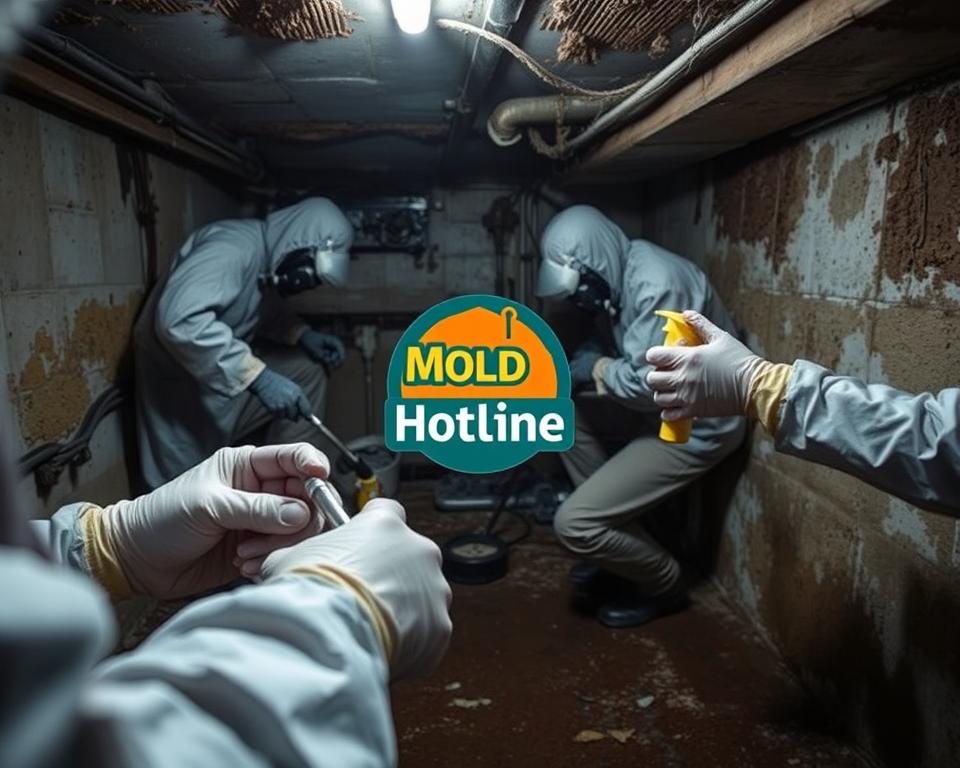
Why Professionals Command Higher Fees
Certified technicians wear protective gear and operate advanced equipment like air scrubbers. Their training prevents cross-contamination during removing mold from porous surfaces. Complex cases requiring containment barriers or structural repairs add labor hours.
Essential Tools and Supplies
High-efficiency particulate air (HEPA) filtration systems trap microscopic spores during cleanup. Antimicrobial treatments and moisture meters ensure complete eradication. Material costs rise when replacing drywall or insulation compromised by fungal growth.
| Cost Category | Average Percentage | Key Components |
|---|---|---|
| Labor | 60% | Safety gear, equipment operation, disposal fees |
| Materials | 40% | HEPA filters, dehumidifiers, replacement building supplies |
DIY mold approaches risk incomplete treatment, allowing hidden colonies to trigger mold spread through air ducts. Professional mold inspection identifies all affected areas, preventing recurring issues. While self-treatment kits cost $30-$150, improper use often leads to costlier remediation later.
Always verify contractor quotes include post-cleanup mold inspection and air quality testing. These steps confirm successful eradication and protect your long-term investment in home health.
affordable mold removal cost per sq ft Overview
Homeowners often underestimate how treatment expenses scale with property dimensions. Professional services typically calculate fees based on contaminated square footage and material penetration depth. This approach ensures fair pricing while accounting for labor intensity and safety measures.
Space-Based Pricing Models
Service providers use standardized rates that increase with affected area size. Recent industry surveys show these typical ranges:
| Area Size | Price Range | Common Scenarios |
|---|---|---|
| 100 sq.ft | $1,000-$3,000 | Small bathrooms, closet spaces |
| 300 sq.ft | $3,000-$9,000 | Basements, attic sections |
| 500+ sq.ft | $8,000-$15,000 | Whole-floor contamination |
Three critical factors influence per-unit pricing:
- Material porosity requiring replacement
- Need for containment barriers
- Air quality testing requirements
Real-World Financial Scenarios
A 200 sq.ft basement project averaged $4,200 after addressing hidden moisture damage. Comparatively, a 150 sq.ft attic job cost $5,100 due to insulation replacement needs. These examples demonstrate how identical square footage can yield different bills based on complexity.
Industry benchmarks reveal that spaces exceeding 300 sq.ft often require 30% more time than smaller areas. Always request detailed measurements during assessments to avoid payment disputes. Certified teams provide infrared scans to verify contamination boundaries before starting work.
DIY Versus Professional Mold Removal
Choosing between tackling microbial issues yourself or hiring experts requires evaluating risks versus resources. Surface-level colonies under 10 square feet might seem manageable, but hidden contamination often demands specialized solutions.
Appropriate Situations for Self-Treatment
Minor visible growth on non-porous surfaces like tiles or glass may respond to household cleaners. Use protective gloves and N95 masks when scrubbing small affected zones. Consider these scenarios where DIY approaches could work:
- Isolated bathroom grout discoloration
- Window sill condensation-related spots
- Vinyl flooring surface colonies
Always test cleaning solutions on inconspicuous areas first. Improper chemical use can damage materials or worsen air quality issues.
Why Expertise Matters for Complex Cases
Certified technicians bring critical advantages for widespread or hazardous contamination. Their protocols prevent spore dispersion during treatment—a common DIY pitfall. Compare key service differentiators:
| Factor | Self-Management | Professional Service |
|---|---|---|
| Safety Gear | Basic respiratory protection | Full-body suits with oxygen systems |
| Containment | Plastic sheeting (optional) | Negative air pressure chambers |
| Testing | Visual inspection only | Infrared moisture mapping |
Structural issues like warped drywall or musty HVAC systems require professional intervention. Health concerns escalate when dealing with toxic species—never risk exposure to save on initial costs.
Final decision tip: Consult specialists if growth reappears after DIY attempts or if anyone experiences allergy-like symptoms. Investing in thorough remediation protects your home’s structural integrity and indoor air safety long-term.
Preventative Measures to Minimize Future Costs
Proactive property care significantly reduces biological growth risks while protecting your investment. Simple habits and strategic upgrades create environments where moisture struggles to thrive. Industry studies show homes with prevention plans experience 70% fewer contamination incidents over five years.
Effective Home Maintenance Practices
Regular inspections of crawl spaces and attics catch early warning signs. Fix plumbing leaks within 48 hours to prevent water absorption into porous materials. Clean gutters quarterly to redirect rainwater away from foundations.
| Task | Frequency | Key Benefit |
|---|---|---|
| Crawl space vapor barrier checks | Biannual | Blocks ground moisture |
| Bathroom exhaust fan testing | Monthly | Reduces humidity spikes |
| Window seal inspections | Seasonal | Prevents condensation |
Long-Term Prevention Strategies
Maintain indoor humidity below 60% using dehumidifiers in damp zones. Upgrade ventilation systems to meet ASHRAE standards for airflow. Choose moisture-resistant building materials during renovations.
“Controlling relative humidity remains the single most effective fungal growth deterrent.”
Install smart sensors in high-risk areas like basements to monitor conditions remotely. Seal concrete floors with epoxy coatings to resist water penetration. These measures create layered defenses against recurring issues.
Estimating Your Mold Remediation Project
Accurate budgeting for microbial issues begins with thorough research and clear communication. Three out of five homeowners discover additional complications during professional assessments, highlighting the value of detailed evaluations. Start by contacting licensed specialists who provide written breakdowns of labor, materials, and containment needs.
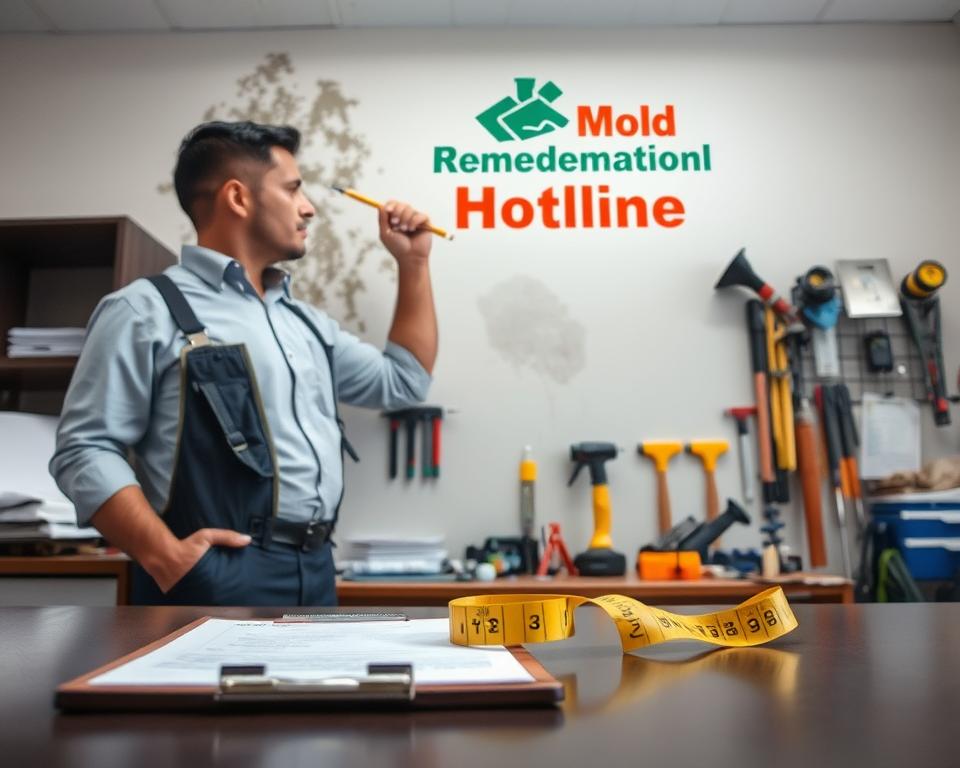
Gathering Multiple Quotes
Request itemized proposals from at least three certified contractors. Reputable companies outline:
- Affected area measurements using infrared tools
- Required safety protocols for hazardous species
- Post-cleanup air quality verification
One Midwest case study showed a $2,800 difference between bids for identical bathroom projects. This variation often stems from undisclosed leaks or overlooked ventilation upgrades.
Understanding Scope Nuances
Review proposals for hidden costs like structural repairs behind walls. Ask specific questions:
| Key Consideration | Follow-Up Action |
|---|---|
| Secondary water damage | Request moisture mapping reports |
| Air duct contamination | Verify HVAC cleaning inclusions |
| Health protection measures | Confirm HEPA filtration use |
Unaddressed leaks in adjacent areas often resurface as costly problems months later. Clarify warranty terms for recurring issues during initial consultations. Proper planning prevents 30% of budget overruns linked to incomplete assessments.
Insurance and Financial Assistance Options
Understanding financial recovery pathways proves crucial when addressing property contamination issues. Many policies exclude coverage unless growth stems from sudden incidents like burst pipes. Documenting moisture sources and damage patterns strengthens claims for eligible scenarios.
Navigating Insurance Claims
Start by reviewing policy language about microbial growth and water-related incidents. Most insurers require proof linking contamination to covered events. Common reimbursements include:
| Repair Type | Average Cost | Coverage Likelihood |
|---|---|---|
| Drywall replacement | $400-$600 per room | High (if leak-related) |
| Flooring removal | $3-$8 per sq.ft | Moderate |
| Basement waterproofing | $2,000-$6,000 | Case-dependent |
Photograph affected materials before cleanup and keep contractor invoices. Disputes often arise over pre-existing moisture issues versus sudden disasters.
Exploring Financial Aid and Cost-Sharing
Federal programs like FEMA grants assist qualifying households after declared disasters. Some states offer low-interest loans for essential home repairs. Consider these options:
- Local housing authority rehabilitation grants
- Energy-efficient upgrade rebates addressing moisture control
- Contractor payment plans for phased remediation
“Documentation of health hazards increases approval odds for assistance programs.”
Nonprofit organizations occasionally provide free testing in high-risk areas. Always compare multiple financing solutions before committing to out-of-pocket payments.
National and Regional Comparison of Mold Removal Costs
Addressing biological contaminants varies significantly across U.S. regions, with service fees reflecting local economic and environmental conditions. A 2023 industry survey revealed price disparities exceeding 65% between coastal cities and rural communities. These variations stem from labor rates, climate challenges, and regulatory standards.
Insights From National Surveys
Recent data shows average nationwide fees range from $1.80 to $6.50 per square foot. Coastal states like Florida and California report higher rates due to humidity-driven spore proliferation. The Midwest averages 22% lower prices, while New England costs align with national medians.
Regional Pricing Dynamics
Urban centers often face steeper charges from specialized contractors. For example, Los Angeles basements average $4.50/sq.ft versus $2.80 in rural Ohio. These differences emerge from three key factors:
| Region | Avg. Price Range | Primary Influences |
|---|---|---|
| Northeast | $2.40-$5.90 | Historic buildings, strict codes |
| Southeast | $1.90-$7.20 | High humidity, hurricane impacts |
| Midwest | $1.60-$4.80 | Lower labor costs, seasonal issues |
| Southwest | $2.10-$6.30 | Limited specialists, arid climate |
Service availability also affects pricing. Only 38% of Wyoming counties have certified spore remediation teams, compared to 94% in New Jersey. Homeowners in remote areas often pay travel surcharges or wait weeks for appointments.
Key takeaway: Always verify contractor certifications and compare localized rates before committing. Regional moisture patterns and building codes create distinct financial landscapes for biological contaminant management.
Conclusion
Managing household contaminants requires balancing immediate actions with long-term planning. Key elements like affected area size, material porosity, and safety protocols determine service expenses. Professional solutions often prove essential for structural issues or hazardous growths, while targeted DIY methods suit minor surface cases.
Homeowners should compare detailed quotes that include air quality testing and moisture mapping. Insurance options vary widely, but documentation strengthens claims for eligible water-related incidents. Preventive strategies like humidity control and routine inspections reduce recurrence risks significantly.
This guide provides benchmarks to evaluate project scope and contractor proposals effectively. Whether addressing a bathroom patch or whole-house infiltration, informed decisions protect both health and property value. Use these insights to create a tailored action plan for maintaining safe indoor environments.
Next steps: Schedule assessments with certified specialists if facing persistent issues. Prioritize repairs that address moisture sources, not just visible growth. Your proactive approach today prevents costly interventions tomorrow.
